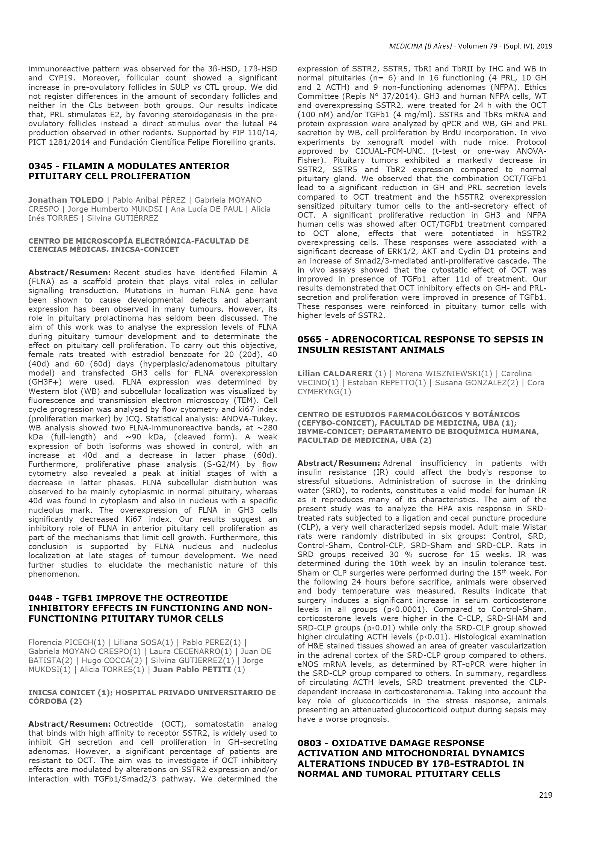Evento
Adrenocortical response to sepsis in insulin resistant animals
Caldareri, Lilian Julia; Wiszniewski, Morena; Vecino, Carolina Veronica ; Repetto, Esteban Martín
; Repetto, Esteban Martín ; Gonzalez, Susana Laura
; Gonzalez, Susana Laura
 ; Repetto, Esteban Martín
; Repetto, Esteban Martín ; Gonzalez, Susana Laura
; Gonzalez, Susana Laura
Tipo del evento:
Reunión
Nombre del evento:
LXIV Reunión Anual de la Sociedad Argentina de Investigación Clínica; LI Reunión Anual de la Asociación Argentina de Farmacología Experimental; XXI Reunión Anual de la Sociedad Argentina de Biología; XXXI Reunión Anual de la Sociedad Argentina de Protozoología; IX Reunión Anual de la Asociación Argentina de Nanomedicinas y VI Reunión Científica Regional de la Asociación Argentina de Ciencia y Tecnología de Animales de Laboratorio
Fecha del evento:
13/11/2019
Institución Organizadora:
Sociedad Argentina de Investigación Clínica;
Asociación Argentina de Farmacología Experimental;
Sociedad Argentina de Biología;
Sociedad Argentina de Protozoología;
Asociación Argentina de Nanomedicinas;
Asociación Argentina de Ciencia y Tecnología de Animales de Laboratorio;
Título de la revista:
Medicina (Buenos Aires)
Editorial:
Fundación Revista Medicina
ISSN:
0025-7680
Idioma:
Inglés
Clasificación temática:
Resumen
Adrenal insufficiency in patients with insulin resistance(IR) could affect the body´s response to stressful situations. Administrationof sucrose in the drinking water (DRS), to rodents, constitutes a valid modelfor human IR as it reproduces many of its characteristics. The aim of thepresent study was to analyze the HPA axis response in DRS-treated ratssubjected to a ligation and cecal puncture procedure (CLP), a very wellcharacterized sepsis model.Adult male Wistar rats were randomly distributed in sixgroups: Control, DRS, Control-Sham, Control-CLP, DRS-Sham and DRS-CLP. Rats inDRS groups received 30% sucrose for 15 weeks. IR was determined during the 10thweek by an insulin tolerance test. Sham or CLP surgeries were performed duringthe 15th week. For the following 24 hours before sacrifice, animalswere observed and body temperature was measured. Results indicate that surgery induces a significant increasein serum corticosterone levels in all groups (p<0.0001). Compared to Control-Sham, corticosterone levelswere higher in the C-CLP, DRS-SHAM and DRS-CLP groups (p<0.01) while only the DRS-CLP group showed higher circulatingACTH levels (p<0.01). Histologicalexamination of H&E stained tissues showedan area of greater vascularization in the adrenal cortex of the DRS-CLP groupcompared to others. eNOS mRNA levels, as determined by RT-qPCR were higher inthe DRS-CLP group compared to others. In summary, regardless of circulating ACTH levels, DRS treatmentprevented the CLP-dependent increase in corticosteronemia. Taking into accountthe key role of glucocorticoids in the stress response, animals presenting anattenuated glucocorticoid output during sepsis may have a worse prognosis.
Palabras clave:
ADRENAL CORTEX
,
INSULIN RESISTANCE
,
SEPSIS
,
CORTICOSTERONE
Archivos asociados
Licencia
Identificadores
Colecciones
Eventos(CEFYBO)
Eventos de CENTRO DE ESTUDIOS FARMACOLOGICOS Y BOTANICOS
Eventos de CENTRO DE ESTUDIOS FARMACOLOGICOS Y BOTANICOS
Eventos(IBYME)
Eventos de INST.DE BIOLOGIA Y MEDICINA EXPERIMENTAL (I)
Eventos de INST.DE BIOLOGIA Y MEDICINA EXPERIMENTAL (I)
Citación
Adrenocortical response to sepsis in insulin resistant animals; LXIV Reunión Anual de la Sociedad Argentina de Investigación Clínica; LI Reunión Anual de la Asociación Argentina de Farmacología Experimental; XXI Reunión Anual de la Sociedad Argentina de Biología; XXXI Reunión Anual de la Sociedad Argentina de Protozoología; IX Reunión Anual de la Asociación Argentina de Nanomedicinas y VI Reunión Científica Regional de la Asociación Argentina de Ciencia y Tecnología de Animales de Laboratorio; Mar del Plata; Argentina; 2019; 1-1
Compartir



